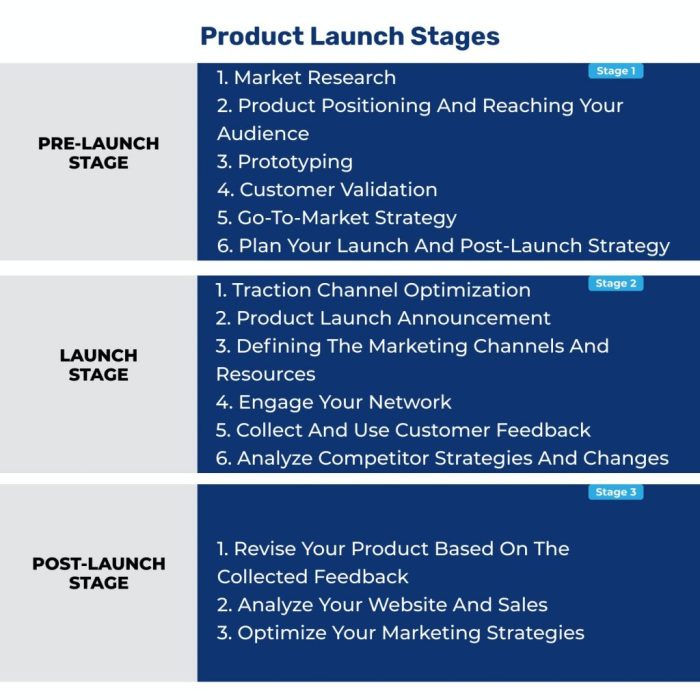Product Launch Strategies set the stage for an epic market debut, revealing the secrets behind successful launches and the crucial elements of a winning strategy. Get ready to dive into a world where innovation meets strategy, and success knows no bounds.
Embark on a journey where market research, target audience identification, competitive analysis, marketing tactics, communication plans, and feedback-driven iterations converge to create a recipe for triumph in the competitive business landscape.
Product Launch Strategies
Effective product launch strategies are crucial for the success of a new product in the market. They help create excitement, generate buzz, and drive sales. Without a well-planned launch strategy, even the best products can go unnoticed.
Examples of Successful Product Launches
- Apple iPhone: Apple creates anticipation by leaking information, hosting live events, and utilizing social media to build hype before the launch.
- Tesla Model 3: Tesla used pre-orders and exclusive launch events to create a sense of urgency and exclusivity around their electric car.
- Red Bull Stratos: Red Bull’s space jump event generated massive media coverage and brand exposure.
Key Components of a Well-Planned Product Launch Strategy
- Market Research: Understand your target audience, competition, and market trends to tailor your launch strategy accordingly.
- Clear Messaging: Communicate the unique value proposition of your product clearly and effectively to capture the attention of consumers.
- Multichannel Approach: Utilize various channels such as social media, PR, influencers, and events to reach a wider audience and maximize exposure.
- Timing: Launch your product at the right time to coincide with market trends, consumer behavior, or special events for maximum impact.
- Feedback Mechanism: Gather feedback from early adopters, influencers, and customers to iterate and improve your product post-launch.
Market Research

Market research plays a crucial role in developing effective product launch strategies by providing valuable insights into consumer preferences, market trends, and competitor analysis. By conducting thorough market research, companies can make informed decisions that increase the chances of a successful product launch.
Influence on Product Launch Decisions
- Identifying target market: Market research helps companies identify their target audience and understand their needs, preferences, and buying behavior. This information guides product development and marketing strategies tailored to meet the demands of the target market.
- Competitor analysis: By analyzing competitors through market research, companies can identify gaps in the market, assess competitor strengths and weaknesses, and position their product effectively to stand out in the market.
- Pricing strategy: Market research enables companies to determine the optimal price point for their product based on consumer willingness to pay, competitor pricing, and perceived value. This information helps in setting competitive prices that maximize profitability.
Methods of Conducting Market Research
- Surveys and questionnaires: Companies can gather feedback from consumers through surveys and questionnaires to understand their preferences, buying behavior, and satisfaction levels.
- Focus groups: Conducting focus group discussions allows companies to delve deeper into consumer insights, perceptions, and emotions towards a product or brand.
- Data analysis: Utilizing data from sources like sales figures, website analytics, and social media metrics can provide valuable insights into consumer behavior and market trends.
- Competitor analysis: Studying competitors through market research tools and industry reports helps companies understand market dynamics, competitive landscape, and areas for differentiation.
Target Audience Identification
To successfully launch a product, it is crucial to identify the target audience. Understanding who your potential customers are can significantly impact the product features and marketing strategies you implement.
Significance of Identifying Target Audience
Identifying the target audience helps in tailoring the product to meet their specific needs and preferences. By knowing who you are targeting, you can develop features that resonate with them, making the product more appealing and increasing the likelihood of a successful launch.
Shaping Product Features and Marketing Strategies, Product Launch Strategies
- By understanding the target audience, you can determine the key benefits and features that matter most to them, ensuring that the product aligns with their expectations.
- Marketing strategies can be crafted to speak directly to the target audience, using language, visuals, and channels that resonate with them, increasing the chances of capturing their attention and driving sales.
- Knowing the demographics, psychographics, behavior patterns, and preferences of the target audience can guide decisions on pricing, distribution, and promotion strategies.
Tools and Techniques for Identifying Target Audiences
- Conduct surveys and focus groups to gather direct feedback from potential customers.
- Utilize analytics tools to analyze website traffic, social media engagement, and other data points to identify characteristics of your target audience.
- Segment your audience based on demographics, psychographics, behavior, and preferences to create targeted marketing campaigns.
Competitive Analysis
When launching a new product, it is crucial to conduct a competitive analysis to understand the market landscape and identify potential threats and opportunities. By analyzing competitors, businesses can position their product effectively and differentiate themselves in the market.
Influencing Product Positioning and Messaging
Competitive analysis can greatly impact how a product is positioned and the messaging used to promote it. For example, if a competitor offers a similar product at a lower price point, a company may choose to emphasize the superior quality or unique features of their own product. By highlighting what sets their product apart from competitors, businesses can attract their target audience effectively.
- Identifying key competitors and their strengths and weaknesses
- Understanding market trends and customer preferences
- Adapting product positioning and messaging based on competitive insights
- Creating unique value propositions to differentiate from competitors
Staying Ahead of Competitors
To stay ahead of competitors during a product launch, businesses can implement various strategies to maintain a competitive edge. This can include continuous monitoring of competitor activities, adapting marketing strategies based on competitor responses, and innovating products to meet evolving customer needs.
- Regularly monitoring competitor pricing and promotions
- Utilizing social media listening tools to track competitor conversations
- Gathering customer feedback to improve product features and customer experience
- Investing in research and development to stay ahead of market trends
Marketing and Promotion
In a successful product launch strategy, marketing and promotion play a crucial role in creating awareness, generating interest, and ultimately driving sales. These activities help to position the product in the minds of the target audience, differentiate it from competitors, and communicate its unique value proposition.
Innovative Marketing Tactics
Recent product launches have seen brands utilize innovative marketing tactics to capture consumer attention and create buzz. Some of these tactics include:
- Collaborations with influencers and celebrities to reach a wider audience
- Leveraging user-generated content and social proof to build credibility
- Interactive and immersive experiences such as virtual events or augmented reality
- Utilizing gamification to engage customers and drive participation
Traditional and Digital Marketing Integration
Successful product launches often involve a mix of traditional and digital marketing channels to reach a diverse audience and maximize impact. This integration allows brands to leverage the strengths of each channel and create a cohesive marketing strategy. Some ways in which traditional and digital marketing channels can be integrated for product launches include:
- Using traditional advertising methods like TV commercials or print ads to build brand awareness
- Implementing digital marketing tactics such as social media campaigns or email marketing to engage with consumers on a more personal level
- Utilizing data analytics to track the performance of both traditional and digital marketing efforts and optimize the overall strategy
Communication Plan
Effective communication is crucial during a product launch as it helps in building excitement, generating interest, and creating awareness among the target audience. A well-defined communication plan ensures that the brand message is delivered consistently across various channels, leading to a successful launch and increased sales.
Importance of a Communication Plan
- Establishing clear objectives and goals for the product launch
- Identifying the target audience and determining the best communication channels
- Creating a timeline for communication activities leading up to the launch
- Ensuring consistent messaging and branding across all communication materials
Effective Communication Strategies
- Utilizing social media platforms to engage with customers and create buzz
- Collaborating with influencers or brand ambassadors to reach a wider audience
- Sending out press releases to media outlets for coverage and exposure
- Hosting launch events or webinars to showcase the product to key stakeholders
Creating a Consistent Brand Message
- Developing a brand style guide to ensure consistency in visuals and messaging
- Training all team members involved in communication on brand voice and tone
- Using the same key messages and taglines across all communication channels
- Maintaining a cohesive look and feel in all marketing materials and advertisements
Feedback and Iteration

Feedback is crucial post-product launch as it provides valuable insights for product improvement. By collecting, analyzing, and implementing feedback, companies can iterate on their products to meet customer needs and stay competitive in the market.
Significance of Gathering Feedback
- Feedback helps identify areas of improvement and potential issues with the product.
- It provides insights into customer preferences and expectations, shaping future product development.
- Feedback allows companies to address any shortcomings and enhance the overall user experience.
Process of Feedback Collection and Implementation
- Collect feedback through surveys, focus groups, customer reviews, and social media interactions.
- Analyze feedback to identify common themes, trends, and areas for improvement.
- Implement changes based on feedback by prioritizing improvements and testing new features.
Case Studies
Apple’s iPhone releases are often driven by customer feedback, leading to iterative improvements in design, features, and user experience.
Netflix regularly gathers feedback from users to enhance their streaming platform, resulting in a more personalized and engaging viewing experience.





